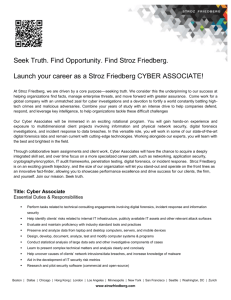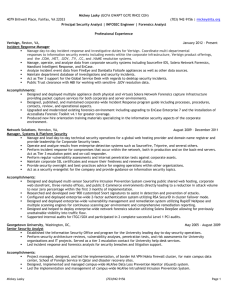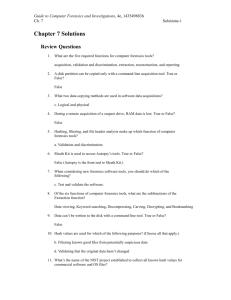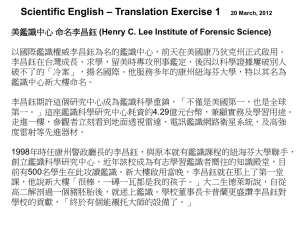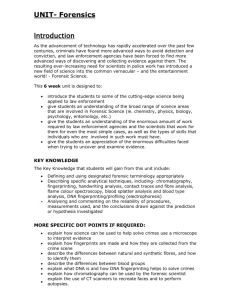A Meta-analysis of the Impact of Forensics and Communication
advertisement
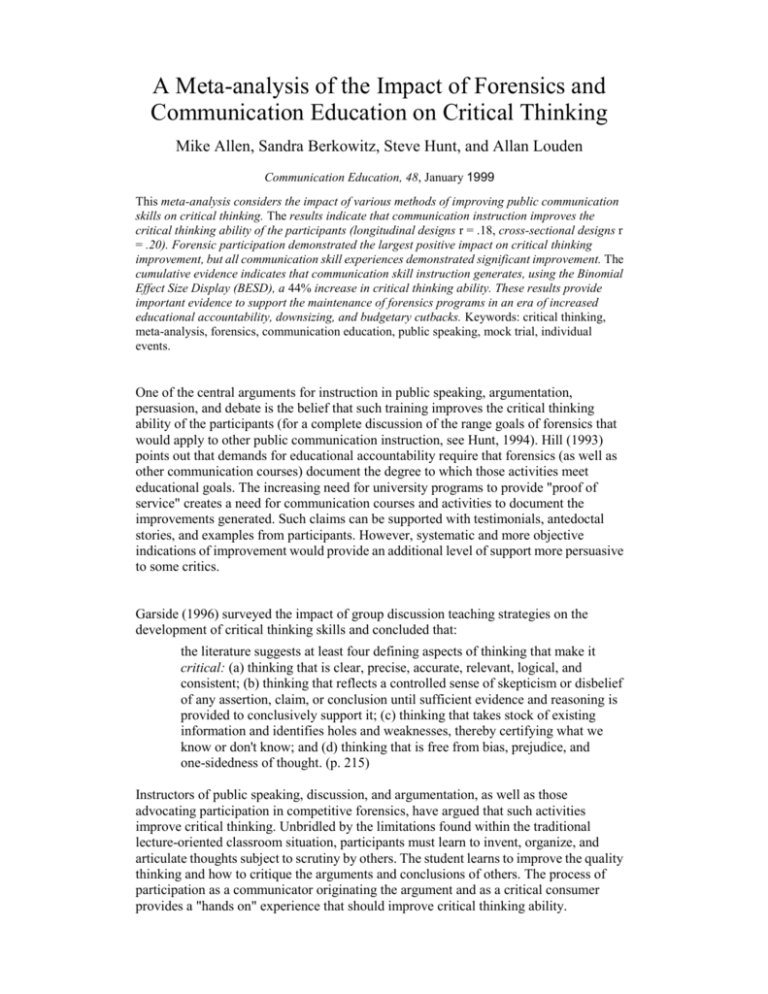
A Meta-analysis of the Impact of Forensics and Communication Education on Critical Thinking Mike Allen, Sandra Berkowitz, Steve Hunt, and Allan Louden Communication Education, 48, January 1999 This meta-analysis considers the impact of various methods of improving public communication skills on critical thinking. The results indicate that communication instruction improves the critical thinking ability of the participants (longitudinal designs r = .18, cross-sectional designs r = .20). Forensic participation demonstrated the largest positive impact on critical thinking improvement, but all communication skill experiences demonstrated significant improvement. The cumulative evidence indicates that communication skill instruction generates, using the Binomial Effect Size Display (BESD), a 44% increase in critical thinking ability. These results provide important evidence to support the maintenance of forensics programs in an era of increased educational accountability, downsizing, and budgetary cutbacks. Keywords: critical thinking, meta-analysis, forensics, communication education, public speaking, mock trial, individual events. One of the central arguments for instruction in public speaking, argumentation, persuasion, and debate is the belief that such training improves the critical thinking ability of the participants (for a complete discussion of the range goals of forensics that would apply to other public communication instruction, see Hunt, 1994). Hill (1993) points out that demands for educational accountability require that forensics (as well as other communication courses) document the degree to which those activities meet educational goals. The increasing need for university programs to provide "proof of service" creates a need for communication courses and activities to document the improvements generated. Such claims can be supported with testimonials, antedoctal stories, and examples from participants. However, systematic and more objective indications of improvement would provide an additional level of support more persuasive to some critics. Garside (1996) surveyed the impact of group discussion teaching strategies on the development of critical thinking skills and concluded that: the literature suggests at least four defining aspects of thinking that make it critical: (a) thinking that is clear, precise, accurate, relevant, logical, and consistent; (b) thinking that reflects a controlled sense of skepticism or disbelief of any assertion, claim, or conclusion until sufficient evidence and reasoning is provided to conclusively support it; (c) thinking that takes stock of existing information and identifies holes and weaknesses, thereby certifying what we know or don't know; and (d) thinking that is free from bias, prejudice, and one-sidedness of thought. (p. 215) Instructors of public speaking, discussion, and argumentation, as well as those advocating participation in competitive forensics, have argued that such activities improve critical thinking. Unbridled by the limitations found within the traditional lecture-oriented classroom situation, participants must learn to invent, organize, and articulate thoughts subject to scrutiny by others. The student learns to improve the quality thinking and how to critique the arguments and conclusions of others. The process of participation as a communicator originating the argument and as a critical consumer provides a "hands on" experience that should improve critical thinking ability. Assuming that such improvement occurs, the conclusion is that the educational advantages of a person able to both generate and critique conclusions provides the basis for quality participation in the society and the academic environment. The conclusion offered is simple: participation in forms of public communication involved in public speaking, forensics (debate, mock trial, individual events), and argumentation requires attention to argument and counterargument. Previous Research A number of investigations exist that compare the impact of various communication skill experiences on critical thinking (Colbert, 1995a; Hill, 1993). The typical investigation in this area takes some group of college students in a course (Allen, Berkowitz, & Louden, 1995; Hurst, 1962;Johnson, 1942; Ness, 1967) or a group of forensics participants (Allen, Berkowitz, & Louden, 1995; Bursack, 1961; Colbert, 1995b) and compares them. The concern of educators has prompted a series of investigations over the past 50 years exploring the impact of communication skill experiences on critical thinking using both longitudinal and cross-sectional designs. A longitudinal design is one where there are multiple measurements on the same set of participants. The measure of the effect is a comparison of the scores from the first time period (pre-test) to the scores at a later time period, after exposure to the communication skills material (post-test). The assumption is that improvement is based on the participation in the training program. The change is the amount of improvement demonstrated between the two measurements. The second type of design, cross-sectional, is a static design (invariably a post-test comparison) between one group participating in some type of communication skills training versus some group that did not. The design represents a classic quasiexperimental design of an experimental and control group. The assumption is that each group started at the same level and the longitudinal comparison illustrates the impact of the differential experiences for the two groups. Typically not taken into consideration is the number of unpublished reports of data that exist. A search of computer indexes and the published literature finds relatively few data sets. However, a number of unpublished doctoral dissertations (Beckman, 1955; Cross, 1971; Frank, 1964; Hurst, 1962;Jackson, 1961; Ness, 1967; Tame, 1958) and unpublished master's theses (Baumgartner, 1965; Beihl, 1963; Bursack, 1961; Smith, 1942) are available. The inclusion or consideration of this set of information expands the available data base. The current data base is sufficient to justify the use of meta-analysis as a means of summarization. The next section of the paper considers various criticisms of the existing literature. If all the available research employed fundamentally flawed designs or measurement, then any proposed summary of the research is meaningless. It is only after the literature is accepted as relevant that any summary becomes useful. Critiques of Existing Research Criticism of research examining the impact of communication skills training on improvements in critical thinking usually considers two issues: (a) measurement of critical thinking and (b) selection of samples used for analysis. The Watson-Glaser tests (in all its forms) represent the dominant form of measurement for critical thinking (for an example of the test see Watson & Glaser, 1951). The paper and pencil objective test uses a multiple choice format. The questions involve tests of five different critical thinking skills (inference, recognition of assumptions, deduction, interpretation, and evaluation of arguments). The test format is usually the use of an example and then some test of an implication that follows. The question is whether the person can, using the accepted rules of inference, understand the permissible conclusions that one can make from the example or available data. The Watson-Glaser test (1951) scores each answer as correct or incorrect. The methodological issue is whether one can measure critical thinking using an objective test and whether an objective test completely captures the domain of critical thinking. The test has a history of adequate reliability, the question is one of validity (Greenstreet, 1993; Hill, 1993). Is the use of a paper and pencil test a "valid" measure of the concept under study? The answer to this depends on how the term "critical thinking" is interpreted. The Watson-Glaser test measures the ability of persons to follow the "rules" involved in various forms of reasoning. To the extent that one accepts the underlying rules, the test is valid. The issue of the Watson-Glaser test and the inadequacy of the available measurement remains a serious one and cannot be resolved by this meta-analysis in a satisfying manner unless a sufficient body of alternative research exists using other measures of critical thinking. But even then, the alternative measures, if they share the same conceptualization, would provide only convergent validity. The second issue regarding the impact of communication skills training on critical thinking deals with the use of forensics participants to measure critical thinking improvement or the impact of forensics participation on critical thinking (this could be extended to other communication skill experiences as well). The argument is that forensic participants are self-selected, and the choice to participate in competitive forensics might be related to higher levels of existing critical thinking. Basically, the claim is that comparisons of forensic participants to nonforensic samples is not a fair comparison because of the bias in self-selection and that any estimate of the impact of forensic participation must consider or remove the impact of this sample bias. The argument applies only when using a cross-sectional design. Longitudinal designs are biased against demonstrating significant gains in forensic participants if this argument were true due to the "ceiling effect." The ceiling effect is the term used to note that a group cannot improve greatly if the performance is already near the top of the scale. If the mean critical thinking score for forensic competitors is higher than the mean of the general population, an improvement score should be lower for forensic participants, since the forensic participants simply have less room to improve than others. The advantage of meta-analysis as a literature summarization technique is that the arguments about measurement and design become the sources and reasons for conducting the analysis rather than for a rejection of the conclusions. Justification for Using Meta-analysis A previous meta-analysis (Follert & Colbert, 1983) concludes that "the results of this analysis cast substantial doubt on the claimed relationship between debate training and critical thinking skill improvement" (p. 2). The conclusion derived from five studies indicates no significant correlation exists between participation in debate and subsequent critical thinking gains. The meta-analysis form Follert and Colbert used generated a set of 47 individual comparisons. Of the 47, 28 demonstrated a gain in critical thinking for debate while 19 did not. The conclusion they offer is that there is no consistent body of evidence for a gain in critical thinking skill. The previous meta-analysis employed a technique using a binomial test of the results of individual significance tests. Unfortunately, the binomial test fails to consider the impact of Type II error and treats each trial as a separate outcome. The result is that the failure to achieve significance does not consider the impact of the separate incidence of Type II error for each sample. In short, the technique used by Follert and Colbert (1983) did not seek to establish an average effect; instead, the effort was made to create a common metric and then to look for consistency among the results of individual significance tests. Rather than averaging effects, the analysis is conducted at the level of individual units employing a vote-counting method. The form of meta-analysis used by Follert and Colbert has been replaced by the other forms of meta-analysis (particularly variance-centered forms, Bangert-Drowns, 1986). Method Literature Search Manuscripts were obtained by searching the available electronic data bases (CO MINDEX, DISSERTATION ABSTRACTS, ERIC, INDEX TO COMMUNICATION JOURNALS, PSYCHLIT), various bibliographies available on the topic (Colbert, 1995b; Follert & Colbert, 1983; Hill, 1993), as well as the reference section of manuscripts obtained. To be included in the analysis a manuscript had to meet the following conditions: (a) contain quantitative data, (b) some type of communication skill improvement exercise (this could be in the form of a course or participation in competitive forensics), and (c) some method of assessing critical thinking skill improvement (either using a cross-sectional or longitudinal design). Coding of Study Features Study features were coded as potential sources of moderating influences. If the average results of the investigations are heterogeneous, then the search for moderator variables (particularly design differences) could serve as an explanation for such inconsistencies. Type of Research Design The investigations included in this analysis used two types of research designs to estimate the impact of communication skill training on critical thinking improvement: longitudinal and cross-sectional designs. Some studies used both types of designs and contributed to both sets of analyses. This information and associated statistical effects appear in Table 1. Type of Communication Skill Experience The type of communication skill improvement approach differed both between and within investigations. The experiences involved competitive forensic participation as well as courses designed to improve the skill of the student in accomplishing some communication task. The longitudinal experience was coded into the following categories: (a) public speaking class, (b) argumentation, debate, and discussion class, and (c) competitive forensics participation (this includes debate, discussion, individual events, mock trial, or other types of participative competitive events). The division represents the type of experiences available to the participant. The coding for individual studies is found in Table 2. The cross-sectional comparisons were divided into three types of comparisons: (a) communication skill activity (forensics, public speaking class, or argumentation class) to a control group, (b) a public speaking or argumentation class to forensics, and (c) an argumentation class (or "special" public speaking class that included a section on argumentation and debate) compared to a public speaking class. The information for individual studies appears in Table 3. The divisions between types of courses or activities based on content provide some type of assessment about whether a particular type of content would most improve critical thinking skills. Competitive forensics is often given academic credit and the provision for such credit is based on critical thinking improvement as well as skill at public presentation. Demonstrating the relative size of the improvements offered in critical thinking for each type of activity provides educators with information on what approach(es) can be expected to generate particular outcomes. Statistical Analysis The data were analyzed using the variance-centered form of meta-analysis developed by Hunter and Schmidt (1990) reflected in the computer programs META- COR (Hamilton & Hunter, 1990) and ATTEN (Hamilton & Hunter, 1991).1 The technique takes the statistical information from investigations and converts the information to a common metric. The form recommended is the correlation coefficient. The estimates for each study are statistically transformed into a correlation. The conversion creates a common metric from each investigation that can be averaged. Transformed data are corrected for a variety of statistical artifacts and possible design limitations. Correction to the data for attenuated measurement (Hunter & Schmidt, 1990) or restriction in range (Hunter & Schmidt, 1990) is possible. This correction can consider the impact of selection artifacts that reflect the possibility of self-selection artifacts for debaters. The impact of both sets of conditions is to systematically underestimate the size of the effect (Allen, Hunter, & Donohue, 1989; Hunter & Schmidt, 1990). Consequently, these corrections serve to increase the size of the existing effect, not reduce it. The average effect is therefore slightly larger after the corrections and the estimate of the variance is larger as well. Each table provides the corrected correlations (r') as well as the uncorrected correlations (r). A confidence interval can be estimated for the average effect (Hunter & Schmidt, 1990, p. 208). 2 The transformed data are then averaged using a formula that weights each correlation by the corresponding sample size. The reason that a weighted average is used is that the assumption is that larger samples provide more accurate estimates of the population effect than do small samples. The level of Type II error is less with larger sample sizes. A study using a small sample size has a larger amount of sampling error and is therefore a less accurate estimate of the population parameter. Weighting by sample size is a recognition of this variability in the accuracy of the estimate. A moderator variable produces subsets where a comparison of the mean effect of each subset demonstrates differences between the groups. No data appear more than once in any particular subgroup, although data sets are used in multiple subgroups. This creates a problem of the data lacking statistical independence. A Monte Carlo test of the impact of lack of independence demonstrates, however, that estimates of both the mean and standard deviation are unaffected by this problem (Tracz, 1984). Results The comparisons in the overall analysis (as well as moderator analysis) consider the two basic types of designs (longitudinal and cross-sectional) separately. The results of the longitudinal designs illustrate that communication skill exercises improve critical thinking (average r = .176, var. = .010, k= 17, N= 2657, 95% Confidence Interval [C.I. +/- .037). Cross-sectional designs find that a communication skill exercise improves critical thinking (average r = .196, var. = .028, k = 13, N = 2395, 95% C.I. +/- .038). The summary data for this and all other sections appear in Table 4. A comparison of the difference in the size of the correlations demonstrates that while the effects observed in cross-sectional designs are larger than those reported by researchers employing longitudinal design (d = .055), the difference is relatively small. The most important finding is that the effects are both positive, indicating that critical thinking improved when either using a longitudinal or cross-sectional comparison. Using Rosenthal's (1984) Binomial Effect Size Display (BESD) technique, a comparison can be made between those participating and those not participating in communication skill improvement programs/classes. Using BESD, the average effect (r = .18) indicates a 44% increase in the number of persons who score above the mean (the increase from 41% to 59%). This improvement in critical thinking ability indicates a large substantial positive influence of public communication training relating to critical thinking. Type of Critical Thinking Measurement Instrument The studies fell into two basic groups: (a) studies that used some version of the Watson-Glaser Critical Thinking Appraisal (1951) or (b) some other measure of critical thinking. Table 1 provides a list of the measures used in each investigation. This analysis for the two different types of measurement instrument groups presents the results separately for the longitudinal and cross-sectional designs. The analysis comparing those studies involving longitudinal designs demonstrates that the studies using the Watson-Glaser measure for critical thinking (average r = .160, var. = .010, k = 12, N= 1875, 95% C.I. +/- .044) showed improvement in critical thinking ability associated with communication skills training. The studies using some other measure observed a similar pattern of positive improvement (average r = .215, var. = .007, k = 5, N= 782, 95% C.I. +/- .068). The comparison of these two average effects demonstrates a larger average for non-Watson-Glaser measures (d = .98). Any argument about the problems associated with the use of the Watson-Glaser scale should reflect the fact that, when compared to other instruments, the Watson-Glaser measurement for critical thinking reported smaller not larger gains for communication skills training. The results using a cross-sectional comparison of a communication skills experience to a control group were divided on the basis of measurement. The Watson-Glaser group demonstrated improvement in critical thinking based on communication skill experience (average r = .192, var. = .029, k = 10, N = 2105, 95% C.I. +/- .041). The group of investigations using other methods of measurement observed an average correlation that demonstrated a positive gain in critical thinking associated with participation in communication skill training (average r = .226, var. = .013, k = 3, N = 290, 95% C.I. +/.108). A comparison of the two mean effects demonstrates the same pattern as the longitudinal data; the Watson-Glaser measure demonstrates a smaller effect than other measures (d = .45). The results indicate that the Watson-Glaser method of measuring critical thinking improvement produces smaller effects than other measures. However, the effect is consistent in direction, if not magnitude, to all the other measures. The evidence suggests the possibility of differential validity for scales, but the consistent pattern indicates convergent validity for the measures. Type of Communication Skill Experience The longitudinal investigations examined the critical thinking gain associated with three different types of skill experiences: (a) public speaking class, (b) argumentation class, and (c) competitive debate/forensics. The longitudinal design makes it possible to measure the improvement for each condition separately and compare effect sizes. Participation in a public speaking course improves the critical thinking skill of students (average r = .145, var. = .066, k = 6, N = 531, 95% C.I. +/- .082). Argumentation classes result in improvement in critical thinking ability (average r = .129, var. = .012, k= 5, N= 549,95%C.I. +/- .081). Competitive forensics participants demonstrated improvement in critical thinking across the investigations (average r = .203, var. = .010, k = 8, N = 1577, 95% C.I. +/- .047). The results indicate that all methods of communication skill training improvement generate gains in critical thinking. The largest effect, however, was observed for competitive forensic participation when compared to a public speaking class (d = .89) or an argumentation class (d = 1.14). The cross-sectional studies permitted a variety of comparisons. The first comparison considered when one group of participants has been part of a communication skill exercise and the change in critical thinking was compared to a control group. The average effect for this comparison demonstrated a larger gain in critical thinking ability for the communication skill exercise group (average r = .241, var. = .025, k = 10, N = 1526,95% C.I. +/- .047). The comparison of competitive forensics to an argumentation or public speaking class demonstrates greater gain (average r = .271, var. = .015, k = 5, N = 455, 95% C.I. +/.084) for competitive forensics participants. A comparison between argumentation classes (or "enhanced" public speaking classes) and normal public speaking classes reveals that the enhanced public speaking classes provide greater improvements in critical thinking (average r = .364, var. = .022, k = 5, N = 362, 95% C.I. +/- .086). Conclusions Unfortunately, this summary cannot adequately address the concerns about the reliance on the Watson-Glaser measure of critical thinking. While other measures of critical thinking [Bursack (1961) used Sarrett's (1951), "How Do You Think Test?"; Douglas (1951) used Johnson's (1942) measure of reflective thinking; Green & Klug (1990) evaluated written essays; Howell (1942) used the California Analogies and Reasoning Test; Tame (1958) used a combination of Bradley's Logical Reasoning Test. Henning's (1946) Problem Recognition Test, and Sarrett's measure] were utilized by investigations, the bulk of existing data rely on the Watson-Glaser measure (in all of its forms). This limitation requires additional research that both develops and utilizes alternative devices. However, while the investigations primarily relied on a single measurement instrument, a comparison to the other measurement efforts produced consistently larger effects. That is, the other devices demonstrated improvement in critical thinking for all the public communication skill efforts, which argues for the generalizability of the conclusion. While primary reliance on the Watson-Glaser instrument may undermine the results should limitations exist in the instrument, use of alternative measurement devices generates similar conclusions. Future research should consider whether instrumentation could be improved or alternative instruments to Watson-Glaser contain similar flaws. The most important outcome of the present meta-analysis is that regardless of the specific measure used to assess critical thinking, the type of design employed, or the specific type of communication skill training taught, critical thinking improved as a result of training in communication skills. The findings illustrate that participation in public communication skill building exercises consistently improved critical thinking. Participation in forensics demonstrated the largest improvement in critical thinking scores whether considering longitudinal or cross-sectional designs.3 The forensics community needs to consider whether the integration of these practices into departmental instruction would be an improvement. The central issue regarding communication, as a field, involves the fact that the process is an action necessary to living. Our field is a lived experience that every person enacts each day. Regardless of the area (organizational, interpersonal, rhetorical, mass, technological, small group, etc.), there exists an aspect of performance and/or competence within that area which is a part of the ongoing theoretical and research tradition. One result, in the cross-sectional comparison, demonstrates that public speaking instruction may be improved by incorporating more aspects of argumentation into the curriculum. The central issue is to what degree the need to develop critical thinking skills plays an important part of the expectations for this or any course. The results demonstrate the value of forensics' participation in improving critical thinking. The effects point to a possible additional advantage that debate and forensics' participation can provide to training solely in public speaking for those interested in the development of critical thinking. The companion activities of engaging in both argument and counterargument, whether required in public speaking, discussion, argumentation, and/or forensics competition better prepare students to become full participants in society. This evidence provides a partial answer to charges of "anti-humanism" in the last few years (Roth, 1996). Competitive forensics, particularly debate, may require the development of critical listening skills, an often underdeveloped part of the practice that is important. This paper provides some evidence for meeting the calls of those asking for evidence of educational accountability. Forensic participation (as well as other forms of public communication instruction) can be justified on the basis of the critical thinking improvement offered. These results provide important evidence to support the maintenance of forensics and other communication skills training programs in an era of increased educational accountability, downsizing, and budgetary cutbacks. Public communication (forensics, argumentation, public speaking), as a part of this larger endeavor, has a contribution to make both to the research, theory, and practice. The forensics community needs to contribute to the issues regarding how to improve the practice. Knowing that our contributions are positive should encourage confidence in our ability to experiment and to evaluate. The challenge is to integrate these experiences as a part of our overall curriculum rather than to view public communication skill training as a separate component. After all, improving critical thinking skills should benefit all students, regardless of the major or which class they next enroll. Future research should consider the impact of public address skills courses on the ability to listen and organize. One would expect that forensics participation (in all its competitive and classroom forms) would generate positive outcomes along a whole host of skills. The ability to listen, organize, and ~e notes all provide a basis for success in a variety of endeavors. Future effort could target the particular activities that stimulate students to develop critical skills. The current results provide evidence for the effectiveness of the techniques but contribute little to the explanation of those effects. The impact of public communication training on the critical thinking ability of the participants is demonstrably positive. This summary of existing research reaffirms what many ex-debaters and others in forensics, public speaking, mock trial, or argumentation would support: participation improves the thinking of those involved. Notes 1 A comparison of this method with other methods of meta-analysis (Johnson, Mullen, & Salas, 1995) demonstrates that this method differs from methods used by Hedges and Olkin (1985) or Rosenthal (1984). Johnson, Mullen, and Salas (1995), demonstrate little difference on the question of mean effect as demonstrated in or on issues of variability. The differences are found in the use of significance testing of the mean effect and moderator prediction. The Hunter and Schmidt (1990) technique demonstrates no improvement in power as the sample size or number of studies increases. The Hunter and Schmidt procedure provides a technique less sensitive to sample size; therefore, it is consistent with the design of the technique to differ from methods that increase in power as sample size increases. Consequently, the estimates in this report are conservative with regard to interpretations of statistical significance. Hunter and Schmidt recommend that the use of the significance test be discontinued, and reliance on confidence intervals be substituted. This report follows that recommendation. 2 There are a number of methods for constructing confidence intervals for mean correlations in meta-analysis (see other methods in Hunter & Schmidt, 1990 as well as Cooper & Hedges, 1994; Hedges & Olkin, 1985). The Hunter and Schmidt (1990) procedure followed treats the mean correlation much as any correlation is based and does not consider directly the variability among the studies or number of studies. Other procedures use different considerations when calculating the confidence interval. Each method of calculation of confidence intervals has different implications for the interpretation of the mean correlation. 3 While the effect is largest for forensics, it should be noted that the confidence intervals with forensics and other types of communication skill exercises overlap. In traditional terms this would indicate that the two groups are not "significantly" different at the .05 level. The use of that term or technique is avoided in this particular form of meta-analysis, which instead relies on confidence intervals. The reader is encouraged to inspect the particular effects and associated confidence intervals provided and apply the relevant standard of assessment in making a decision I about how to describe the difference. References *indicates manuscript contributing data used in the statistical portion of the meta-analysis *AIlen, M., Berkowitz, S., & Louden, A. (1995). A study comparing the impact of communication classes and competitive forensic experience on critical thinking improvement. The Forensic, 81, 1-7. Allen, M., Hunter,]., & Donohue, W. (1989). Meta-analysis of self-report data on the effectiveness of public speaking anxiety treatment techniques. Communication Education, 38, 54-76. Bangert-Drowns, R (1986). Review of developments in meta-analytic method. Psychological Bulletin, 99, 388-399. *Baumgartner, A. (1965). An experimental study of speech fundamentals unit in public speaking upon organization skill and critical thinking ability. Unpublished master's thesis, University of Nebraska, Lincoln. *Beckman, V. (1955). An investigation of the contributions to critical thinking made by courses in argumentation and discussion in selected colleges. Unpublished doctoral dissertation, University of Minnesota, Minneapolis. *Beihl, E. (1963). An analysis of the critical thinking ability of speech 1 students at the University of Kansas in the summer of 1963. Unpublished master's thesis, University of Kansas, Lawrence. *Brembeck, W. (1947). 17ze effects of a course in argumentation on critical thinking ability. Unpublished doctoral dissertation, University of Wisconsin, Madison. *Brembeck, W. (1949). The effects of a course in argumentation on critical thinking ability. Speech Monographs, 16, 172-189. *Bursack, L. (1961). The effect of high school debating on knowledge of the subject, attitude toward issues, and critical thinking. Unpublished master's thesis, Washington State University, Pullman. *Colbert, K (1987). The effects of CEDA and NDT debate training on critical thinking ability. Journal of the American ForensicAssociation,23,194-201. *Colbert, K (1995a). 17ze debate-critical thinking relationship: Isolating the effects of self-selection. Paper presented at the annual meeting of the Speech Communication Association, San Antonio, TX. Colbert, K (1995b). Enhancing critical thinking ability through academic debate. Contemporary Argumentation and Debate, 16,52-72. Cooper, H., & Hedges, L. (Eds.). (1994). The handbook of research synthesis. New York: Russell Sage Foundation. Cross, G. (1971). The effects of belief systems and the amount of debate experience on the acquisition of critical thinking. Unpublished doctoral dissertation, University of Utah, Salt Lake City. *Douglas, J. (1951). An experimental study of training in problem-solving methods. Unpublished doctoral dissertation, Northwestern University, Evanston, IL. *Douglas, J. (1952). An experimental study of training in verbal problem solving methods. Speech Monographs, 19, 115-116. Follert, V., & Colbert, K. (1983, November). An analysis of the research concerning debate training and critical thinking improvements. Papet presented at the annual meeting of the Speech Communication Association, Washington, DC. (ERIC Document #ED 238 058) *Frank, A. (1964). An experiment in teaching critical thinking in a high school speech fundamentals course. Unpublished doctoral dissertation, University of Wisconsin-Madison, Madison. Garside, C. (1996). Look who's talking: A comparison of lecture and group discussion teaching strategies in developing critical thinking skills. Communication Education, 45,212-227. *Green, C., & KIug, H. (1990). Teaching critical thinking and writing through debates: An experimental evaluation. Teaching Sociology, 18, 462-471. Greenstreet, R (1993). Academic debate and critical thinking: A look at the evidence. National Forensic Journal, 11, 13-28. Hall,]., & Rosenthal, R (1991). Testing for moderator variables in meta-analysis: Issues and methods. Communication Monographs, 58, 437-448. Hamilton, M., & Hunter,]. (1990). META-COR. Unpublished computer program for conducting meta-analysis on correlations, East Lansing, MI. Hamilton, M., & Hunter, J. (1991). ATTEN. Unpublished computer program for correcting correlations for artifacts, East Lansing, MI. Hedges, L., & OIkin, I. (1985). Statistical methods for meta-analysis. Orlando, FL: Academic Press. Henning, J. (1946). An experimental study of the role of presumption and the burden of proof in problem solving. Unpublished doctoral dissertation, Northwestern University, Evanston, IL. Hill, B: (1993). The value of competitive debate as a vehicle for promoting development of critical thinking ability. In A. Gill (Ed.), CEDA Yearbook 14 (pp. 1-22). Dubuque, IA: Kendall/Hunt Publishing Company. *Howell, W. (1942). The effects of high school debating on critical thinking. Unpublished doctoral dissertation, University of Wisconsin-Madison, Madison. *Howell, W. (1943). The effects of high school debating on critical thinking. Speech Monographs, 10, 96-103. Hunt, S. (1994). The values of forensic participation. In T. Winebrenner (Ed.), Intercollegiate Forensics (pp. 1-19). Dubuque, IA: Kendall/Hunt Publishing Co. Hunter,]., & Schmidt, F. (1990). Methods of meta-analysis: Correcting for error and bias in research results. Beverly Hills, CA: Sage. *Hurst, C. (1962). Speech and functional intelligence: An experimental study of education implications of a basic speech course. Unpublished doctoral dissertation, Wayne State University, Detroit, MI. *Jackson, T. (1961). The effects of intercollegiate debating on critical thinking. Unpublished doctoral dissertation, University of Wisconsin-Madison, Madison. Johnson, A. (1942). An experimental study in the analysis and measurement of reflective thinking. Unpublished doctoral dissertation, Northwestern University, Evanston, IL. Johnson, B., Mullen, B., & Salas, E. (1995). Comparison of three major meta-analytic approaches. Journal of Applied Psychology, 80, 94-107. Ness, J. (1967). The effects of a beginning speech course on critical thinking ability. Unpublished doctoral dissertation, University of Minnesota, Minneapolis. Rosenthal, R (1984). Meta-analysis procedures for social research. Newbury Park, CA: Sage. Roth, M. (1996,January/February). On the limits of critical thinking. Tikkun, 33, 85-86. Sarett, L., Foster, W., & McBurney,J. (1951). Speech. Boston: Houghton Mifflin Company, Inc. *Smith, D. (1942). Experiment in teaching critical thinking in a high school speech class. Unpublished master's thesis, University of Wisconsin-Madison, Madison. *Tame, E. (1958). An analytical study of the relationship between ability in critical thinking and ability in contest debate and discussion. Unpublished doctoral dissertation, University of Denver, CO. Tracz, S. (1984). The effect of the violation of the assumption of independence when combining correlation coefficients in a meta-analysis. Unpublished doctoral dissertation, Southern Illinois University, Carbondale. Watson, G., & Glaser, E. (1951). Critical thinking appraisal, Form YM New York: Harcourt, Brace, & World, Inc. *Whalen, S. (1991). Intercollegiate debate as a cocurricular activity: Effects on critical thinking. In D. Parson (Ed.), Argument in controversy: Proceedings of the 7th SCA/AFA Conference on Argumentation (pp. 391-397). Annandale, VA: Speech Communication Association.


